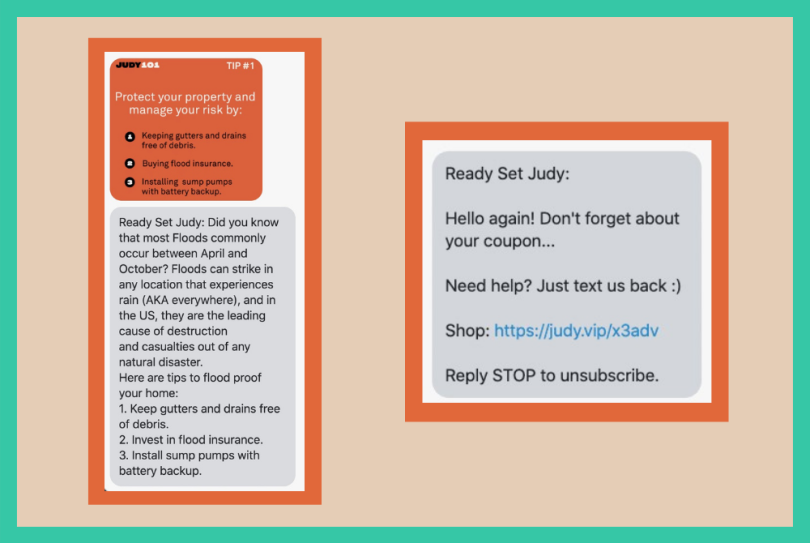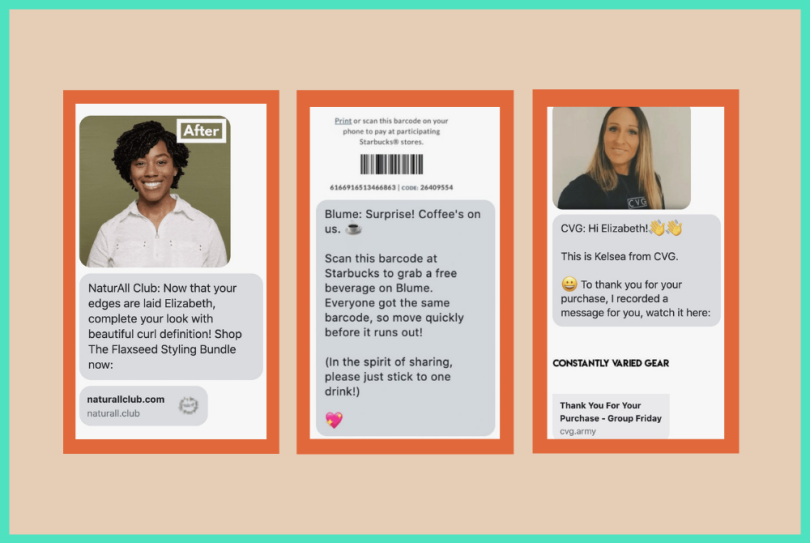Text message marketing is having a revival.
Also known as SMS marketing, this practice has long had a reputation for being outdated, spammy and impersonal. Most people have experienced it in the form of appointment reminders, food-app delivery notifications and requests for political campaign donations.
But some brand marketers see SMS as an increasingly effective channel for building and deepening relationships with customers — especially at a time when people are turning to brands for community and connection.
“Look around, everyone’s on their phone all the time,” said Alicia Thomas, director of community at Postscript, a company whose SMS marketing products are used by Shopify merchants. “It’s about meeting the consumer where they’re most engaged.”
“It’s about meeting the consumer where they’re most engaged.”
At its worst, SMS marketing can feel like an intrusive chatbot. At its best, though, it can establish a strong connection between brands and fans.
Texting has “the ability to cut through the din of email newsletters and really create a meaningful relationship,” Mike Donoghue, co-founder and chief executive of the SMS marketing platform Subtext, told Built In.
If you’re thinking about getting into SMS marketing, here’s what you need to know.
SMS Engagement Rates Are High
Most emails get deleted before they’re read. Reports suggest that the average open rate for marketing emails hovers around 20 percent, which means about 80 percent of what email marketers say isn’t getting through.
For text message marketing, that number is much higher. Depending on the source, SMS open rates are said to range between 82 percent and 98 percent. People using the Subtext platform clock an average open rate of 92 percent, Donoghue said. About 85 percent of messages get opened within an hour after being sent.
One reason: We haven’t adopted technologies — nor habits — for filtering out texts by sender.
“With email ... it can go to the promotions tab, it can go to spam,” Postscript’s Thomas said. “But with text, it’s going to come right to your phone — you’re going to open the message.”
And people aren’t just reading SMS marketing messages. Many are replying too — at much higher rates than through channels like email and social media.
SMS Can Be Used for Customer Retention
For many companies, the cost of acquiring new customers has gotten out of hand, which puts pressure on maximizing customer lifetime value.
SMS marketing is often used to encourage repeat purchases, letting customers know when a product they bought in the past is available in a new color, or if a new product that’s relevant to their interests is about to drop. And, using order history data, SMS marketing tools can alert customers that it’s time to replenish their home inventories.
It can also provide a way for customers to reorder without the friction of downloading an app or logging into a website.

SMS Works for Customer Acquisition Too
Companies can also use texting to nurture top-of-funnel relationships and build subscriber lists from scratch.
For example: Around the holidays last year, BuzzFeed held office hours on Subtext, and people could text in their questions asking for specific gift recommendations. BuzzFeed had someone respond with suggestions and point to relevant deals they found around the internet.
Abercrombie & Fitch has used SMS as an acquisition tool too. The clothing retailer has held a text-to-win contest, inviting people to text them in exchange for a free gift card that ranged anywhere from $5 to $500.
There’s also Great Jones, which sells cookware. The company lets anyone text its hotline (named Potline) for real-time cooking advice. You don’t have to be an existing customer to use it.
These companies used SMS in a variety of ways to create value for people without selling them something. But of course, it also allowed them to acquire the phone numbers of prospective customers whom they could reach out to down the road.
SMS Works Best When It’s Conversational
Using SMS for a one-way broadcast is a mismatch for such a personal medium. Brands see more traction with customers when they adopt a conversational tone.
“Think about it as a way to humanize your brand,” Donoghue said.
Not every text has to be a coupon code, flash sale or new product drop. Often, it can be an invitation to a dialogue, or a behind-the-scenes look into something interesting the company’s doing.
“If you look at the traditional way that SMS has been used in marketing, it’s really just a little bit more of an intimate way to notify somebody of something,” Donoghue added. “If I can open up a dialogue with a company, brand, or creator, that’s really valuable to me.”
Other companies have experimented with texting people recipes, playlists and no-strings-attached gifts. Delightful gestures that don’t feel like a sales pitch. Things a friend might text.
SMS Is Easy to Overdo
Given the high open rates, some companies may be tempted to turn on the texting spigot. Experts suggest companies exercise caution though. Because even if people like you, that doesn’t mean they want to hear from you all the time.
“Text is such a sensitive channel,” Thomas said. “If you’re going to send [texts] all the time, people are just going to cut you off.”
She said marketers are still trying to find that line, and pinpoint the sweet spot where their SMS marketing efforts are effective but not intrusive.
“SMS is a sacred place on people’s phones,” Donoghue said. “You really need to treat it like that.”
Text is one of the last remaining modes of communication that people primarily reserve for family and friends. If they’re going to let brands into that circle, brands need to find a cadence that creates maximum value for recipients.
“Listen to your audience, and figure out what they determine to be the appropriate cadence of messaging,” Donoghue said.
He suggests reacting quickly — see what works, and adjust accordingly.
SMS Can Be Segmented and Automated
SMS marketing is designed to give a personal touch while still being scalable.
It costs money for companies to send text messages. So it’s in their best interest to be efficient.
That’s why companies segment their SMS subscriber lists based on several data points, such as order history, geographical location, behavioral data and responses to questions or polls the company texts them. This allows companies to send specific messages to specific subscribers at specific times. The customized approach is much more effective than blasting the entire subscriber list with a one-size-fits-all message.
“When you segment based on what people are doing, and [how they are] interacting with your brand,” Thomas said, “you’re going to get a lot higher response rate.”
For example, if you’re a brand that’s launching a new line of yellow shirts, and you want to let everyone who’s bought matching yellow pants know about it, you could text only them.
“You’re saving money [and] making more impact by being more direct,” Thomas said.
SMS Marketing and Email Marketing Should Work Together
Text is a different medium than email. So it should sound different.
“A lot of people who sign up to do text are like, ‘Oh, cool, I’m just gonna send a text version of my email strategy,’ which we’re like, ‘Don’t do that,’” Thomas said. “Because really, it’s a different experience. People expect to have that human conversation and tone.”
She recommends companies make their texts more compact and a bit friendlier than emails, occasionally sprinkled with emoji and GIFs.
More importantly, Thomas said, a company’s email and SMS efforts should work in tandem. They should both be on the same page in terms of the subscriber’s behavior, to ensure a smooth experience across both channels.
So if a customer abandons their cart before making a purchase, for example, the company can follow up with an email later that day, and follow up through SMS the day after that.
Companies using SMS and email should be “thinking about how those two channels interact together, as opposed to duplicating efforts,” Thomas said, “so people don’t feel like they’re getting the same messages all the time.”

SMS Lets You Own the Relationship With Your Audience
An advantage of building a subscriber list through text messaging is that it allows companies to own the relationship with their audience, Donoghue said, “versus renting it from Facebook or Instagram or Twitter.”
These social platforms can be helpful, he added — in the past they have been a boon for brands trying to build audiences. But due to their ever-evolving algorithms, they are also volatile. There’s no guarantee that companies will be able to continue connecting effectively to their audiences on these platforms.
SMS, on the other hand, is more durable. The subscriber list can’t be taken away by a third party, which makes it all the more valuable.
SMS Works for Different Verticals
DTC brands aren’t the only ones using SMS marketing to connect with their customers.
The channel is also used by several individual celebrities and media companies looking to create more personal and interactive relationships with their audiences.
It’s still early days, but SMS marketing is coming for tech companies too.
Donoghue threw out a hypothetical: If he were an enterprising software company, he would set up and nurture SMS-based communities for people who want product demos or who want to learn more about the tech, and eventually leverage them as top-of-funnel opportunities for people to convert into paying customers.
Does Subtext use Subtext, for its own marketing purposes?
“If you want to be able to text with the chief strategy officer at Subtext,” Donoghue said, “you can absolutely do that.”




